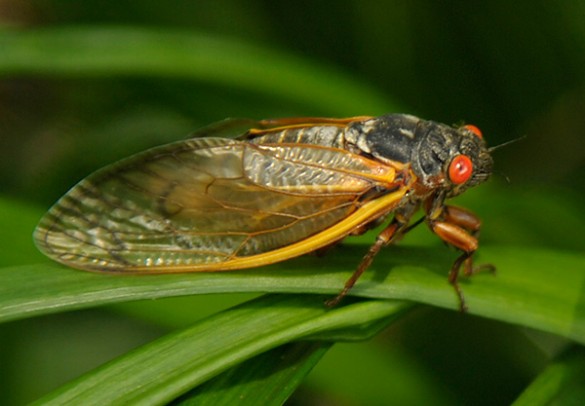
According to Associate Professor of Biological Sciences Patrick Abbot, cicadas play an important role in the ecosystem and there is a considerable amount of research being done to understand it better.
Cicadas may be big and ugly, but they do not bite or sting. They feed exclusively on tree sap. But for the five or six weeks when periodic cicadas emerge – like the brood that is currently making its 13-year appearance in Middle Tennessee – they are the most abundant herbivore in the broadleaf forests of North America in both number and biomass.
“[rquote]Cicada populations have been measured at numbers as high as 1.5 million per acre. That translates to about 800 tons per square mile[/rquote],” said Abbot. (Locusts are the only other insect species that congregates in such large biomass densities.)
Unlike locusts, cicadas do very little damage to their environment. Generally, the females lay their eggs on the branches of mature trees that usually appear to survive the onslaught quite well. If too many females pick a given branch it can cause leaves and twigs to brown, a condition called flagging.
When the eggs hatch, the larvae drop to the ground below the tree where they burrow into the ground. In the years they live underground, the nymphs feed on sap that they drain from the tree’s roots. But they grow very slowly and so don’t have a visible impact on their hosts. There is even some evidence that the bodies of the nymphs can provide essential nutrients for tree growth in some environments, Abbot said.

During their underground stages, cicadas are a favorite food of shrews and moles. When they emerge, they provide a veritable feast for a number of bird species, including starlings and robins, squirrels, turtles and snakes. There are species of spiders and wasps that also like to lunch on the insects. There are even fungi that specialize in feeding on cicada.
According to Abbot, there are a couple of reasons why cicadas swarm in such large numbers. One is predator satiation. They simply overwhelm their predators’ collective appetite ensuring that enough females survive long enough to lay their eggs. The other basic reason is that it simplifies the problem of finding mates.
There are a number of theories about why the cicadas emerge on 13- and 17-year cycles, Abbot reported.
One is that it significantly increases the length of time between periods when different broods emerge at the same time.
“Say you have two populations, one which emerges every five years and one which emerges every 10 years. Then they would emerge simultaneously every 10 years, whereas the period between simultaneous emergences between populations with 13- and 17-year cycles is 221 years,” said Abbot.
Frequent “resynchronizations” allow hybridization, the mixing of genes through interbreeding. Under simple genetic scenarios, this produces offspring with intermediate life cycles. If the population densities are low then these offspring have difficulty finding mates.
“What you are left with are the annual cicadas, which appear every year even though they spend multi-year periods underground.”
Want more? Read Research News @ Vanderbilt Blog post about cicadas.